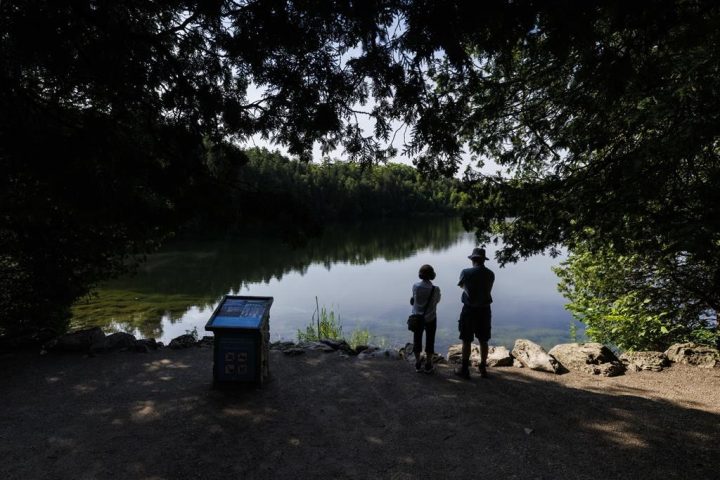A team of geologists has concluded, after a studying sites around the globe, that a tiny, deep lake in southern Ontario should mark the birth of the modern world.

A few layers of sediment from around 1950 at the bottom of Crawford Lake, they say, show more clearly than anywhere else how human activities have changed the planet’s functioning to the extent that a new geological epoch should be declared: the Anthropocene, or the age of people.
“It’s a bit sobering,” said Francine McCarthy, a Brock University geologist who was on the research team for the Anthropocene Working Group of the International Union of Geological Sciences.
“Within that short span of time, the system flipped and can’t go back to the way it used to be.”
Her group says the lake along the Niagara Escarpment should be considered the location for the so-called “Golden Spike” marking the start of the Anthropocene.

The recommendation was announced Tuesday at the International Congress on Stratigraphy in Lille, France.
Geologists are to debate the issue, including whether the Anthropocene should be declared at all, in the fall. The matter is to come to a final vote at the International Union of Geological Sciences in August 2024.

Get breaking National news
That will bring to a close a debate geologists have been having since 2009: have humans altered the planet’s functioning profoundly enough to change its geology, and if so, should a new geological epoch be declared?
Some geologists initially suggested a new epoch should begin with the Industrial Revolution, when fossil-fuel combustion began in earnest.
But many currently prefer the year 1950.
That’s when plutonium-239 begins to show up in geological strata. The element does not occur in nature and is the result of widespread nuclear weapons testing.
The year also coincides with the beginning of the so-called “Great Acceleration,” a time when everything seemed to suddenly take off.
A 2015 paper in the journal Anthropocene Review produced 12 graphs on everything from population to GDP to fertilizer use to dam construction to energy consumption to international travel. They all spike dramatically right around 1950.
Many of these accelerations show up in the geological record.
Fertilizer use changes which nitrogen compounds are deposited. Atmospheric changes alter what filters down from the sky.
“Anything that came out of smokestacks or tailpipes, that’s what we see,” McCarthy said.
All of the 12 candidates considered for the Golden Spike showed the same signals, said McCarthy.
“It’s a tipping point. It flips on a dime, everywhere.”
The scientists chose Crawford Lake because of the remarkable clarity and depth of its sedimentary record. Because of its significant depth — 24 metres — and narrow surface of a few hectares, Crawford’s deeps never mix and are essentially cut off from the world.
That leaves pure layers of sediment drifting from the surface, leaving a climatic and atmospheric record so undisturbed that large parts of it can be read year by year, going back to Indigenous users of the area in the 13th century.
Markers of the Great Acceleration are clear in Crawford, McCarthy said.
“Tests done in independent labs confirm that each of these things like dominoes changes very, very quickly right around 1950,” she said in a press briefing last week.
“So I think that’s why the Anthropocene Working Group chose our site in the end.”
McCarthy acknowledged some geologists remain unconvinced by the need for a new epoch.
“It’s never been done before for anything this recent and such a short interval. It’s meeting with some resistance because it’s outside the norm.”
Others argue that at most, 1950 could mark the start of a new age of our current epoch, the now 12,000-year-old Holocene. It would be called the Crawfordian Age.
Either way, McCarthy said the concept unites geology with the humanities.
“Historians and earth scientists don’t usually have a lot to do with each other. But in the case of the Anthropocene, they do.”
The idea has also caught on in popular culture.
“It resonates with people,” she said.
If nothing else, MCarthy said the selection of Crawford Lake as the Anthropocene’s Golden Spike would finally define what we mean by the term.
“When we say the word Anthropocene and have the word epoch after it, we mean precisely what is defined on the basis of Crawford Lake. That’s what the Golden Spike would do.”








Comments